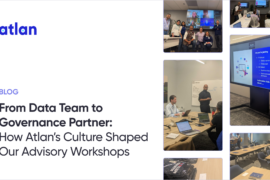The Seven Pillars of Platform Team is a set of core values that guide the development of our technology platform. They include scalability, reliability, security, innovation, affordability, observability, and extensibility.

In this blog, we outline these pillars and share more about how they guide the work done by the platform team at Atlan.
⚖️ Scalability
Scalability is the ability of a system or platform to handle increasing amounts of data or traffic without sacrificing performance or stability. In other words, a scalable system can handle growth and changing demands without breaking or becoming less efficient.
Scalability is crucial for any technology platform as it ensures the system can handle increasing users, data, and traffic without impacting its performance or stability. Ensuring scalability means the system can grow and adapt to changing demands without significant modifications or upgrades.
For example, if a platform experiences a sudden surge in traffic or data, a scalable system can handle the increased load without issues. On the other hand, a non-scalable system may become slow or unstable, resulting in a poor user experience.
From the beginning, the platform team must design the system with scalability in mind to achieve scalability. This can involve distributed systems, load balancing, and horizontal scaling. By prioritizing scalability, the platform team can ensure that the platform can grow and adapt to changing demands without sacrificing performance, stability or efficiency.
🔯 Reliability
Reliability refers to the ability of a system or platform to perform consistently as intended without failure or downtime. A reliable system is one that users can trust to be available and functioning correctly at all times. Achieving reliability involves building redundancy and fail-safes into the system, and monitoring and addressing potential issues before they impact users. The platform team must prioritize reliability to ensure users consistently rely on the platform to meet their needs.
In addition to building redundancy and fail-safes into the system, achieving reliability also involves conducting regular maintenance and updates to ensure the system is up-to-date and functioning correctly. The platform team must also have the plan to address potential issues or downtime and communicate this plan to users to ensure transparency and trust.
Reliability is crucial for any technology platform as it directly impacts the user experience. A reliable system ensures users can access the platform when needed and function correctly without errors or unexpected downtime. By prioritizing reliability, the platform team can build trust with users and ensure the platform meets their needs consistently.
🛡️ Security
Security protects a system or platform against unauthorized access, data breaches, and malicious attacks. Achieving security involves implementing measures to prevent, detect, and respond to potential threats, including encryption, authentication, and access controls. The platform team must prioritize security to protect user data and maintain user trust.
Ensuring security involves identifying potential vulnerabilities in the system and implementing measures to address them. This can include regular security audits and testing, implementing firewalls and intrusion detection systems, and ensuring user data is encrypted and protected. The platform team must also have a plan to address potential security breaches and communicate this plan to users to ensure transparency and trust.
Security is crucial for any technology platform as it directly impacts the protection of user data and the overall trust users have in the platform. By prioritizing security, the platform team can protect user data and maintain user trust, which is essential for the platform’s success.
🎖️ Innovation
Innovation refers to the ability to develop new and creative solutions to problems and continually improve the technology platform. Achieving innovation involves exploring new technologies and approaches, identifying areas for improvement, and continuously testing and iterating on the platform. The platform team must prioritize innovation to ensure the platform stays competitive and meets the evolving needs of users. By prioritizing innovation, the platform team can develop new and improved features and functionality that meet the changing needs of users and stay ahead of competitors.
Innovation is a vital pillar of any successful technology platform. By constantly exploring new ideas and approaches, the platform team can identify areas for improvement and develop new features and functionality that meet the changing needs of users. This can include exploring new technologies, testing and iterating on existing features, and continually seeking feedback from users to identify areas for improvement.
Prioritizing innovation can also help the platform stay ahead of competitors in a rapidly changing technology landscape. By developing new and improved features and functionality, the platform can attract new users and retain existing ones, ensuring its continued success.
However, it’s important to note that innovation should not come at the expense of other pillars, such as scalability, reliability, and security. Innovation must be balanced with these other priorities to ensure the platform remains stable and secure while staying competitive and meeting the evolving needs of users.
In summary, innovation is a crucial pillar of any technology platform, and the platform team must prioritize it to stay competitive and meet the changing needs of users. By exploring new technologies and approaches and continually improving the platform, the team can attract and retain users and ensure the platform’s continued success.
💰 Affordability
Affordability is essential to any technology platform, allowing a better approach to ensure Cloud cost is minimum, any feature, or capability supported by the Platform should have the least impact on the platform running cost.
Avoid abuse, identify gaps where cost is spent, and use technology to optimise the areas where cost can be further reduced. Thinking of cost can be a secondary approach, it should be considered before even starting execution on any component.
📈 Observability
Observability refers to the ability of the platform team to monitor and understand the system’s behaviour and performance, including identifying and addressing potential issues before they impact users. Achieving observability involves implementing monitoring and logging tools that provide visibility into the system’s behaviour and performance, including metrics, logs, and traces. The platform team must prioritize observability to ensure the system performs optimally and meets user needs.
By prioritizing observability, the platform team can identify and address potential issues before they impact users. This can involve setting up alerts and notifications for specific metrics, regularly reviewing logs and traces, and conducting regular performance testing to identify areas for improvement. Observability also enables the platform team to gain insights into user behaviour and usage patterns, which can inform future development and improvements.
⛓️ Extensibility
Extensibility refers to the ability of the platform to support the integration of new features, functionality, and services. Achieving extensibility involves designing the system with modularity and flexibility, allowing for easy integration of new components and services. The platform team must prioritize extensibility to ensure the platform can evolve and adapt to changing user needs and new technologies.
By prioritizing extensibility, the platform team can ensure the platform remains relevant and competitive by easily integrating new features and functionality. This can involve designing APIs and SDKs that enable easy integration with third-party services and components, and developing a modular architecture that allows for the easy addition and removal of components.
In summary, the “Seven Pillars of Platform Team” is a set of core values that guide the development of a technology platform. Prioritizing scalability, reliability, security, innovation, affordability, observability, and extensibility ensures the platform performs optimally, meets user needs, and stays ahead of competitors. By continually evaluating and improving these pillars, the platform team can ensure the platform’s continued success.





